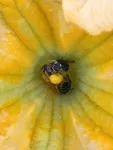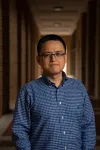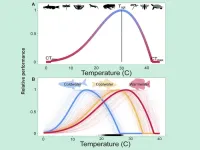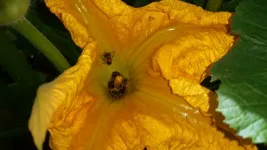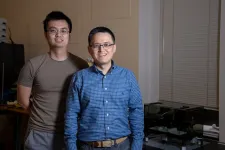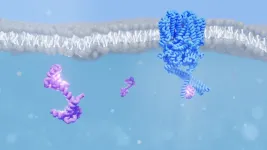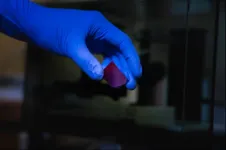(Press-News.org) One in eight Texans experiences food insecurity, according to the non-profit agency Feeding America. That means 1.4 million Texas households are food insecure, with limited or inconsistent access to nutritious food for an active, healthy life. The USDA's most recent survey on the issue reported that Texas is among the top nine U.S. states with a higher prevalence of food insecurity than the national average.
To address this issue, a University of Houston-led team is developing an artificial intelligence-based platform that can support the food charity ecosystem through data-driven technologies.
"The commitment of our team is to help our fellow neighbors," said Ioannis Kakadiaris, principal investigator and Hugh Roy and Lillie Cranz Cullen Distinguished University Professor of Computer Science at UH's College of Natural Sciences and Mathematics. "This is evident in everything we do and permeates all our work."
Funded by a $750,000 grant from the National Science Foundation, the project aims to help food pantries communicate with other pantries, food donors, and agencies while also helping to provide culturally aware and personalized food to clients.
On the demand side, there must be the identification of the nutritional needs, cultural preferences, and food preparation equipment and supplies of food-insecure households, according to Kakadiaris. If someone does not know what a particular food is or how to prepare it, it will go to waste, and the efforts of the food charity ecosystem will fail, he added. On the supply side, there needs to be streamlined logistics, improved communication, and coordinated efforts between the various stakeholders in the food charity system to optimize the supply chain so that inefficiencies are minimized.
The platform will potentially use food delivery services like DoorDash to transfer the food. In turn, food donors could be rewarded for their charitable donations.
"Donors could receive NFT (non-fungible tokens) that will say how good of a donor they have been in the past month," Kakadiaris said. "I envision having gold, silver, or bronze donors, depending on how much food they have donated over the past month or week."
The research team from UH includes Norma Olvera, professor of education and a USDA E. Kika de la Garza Fellow; Elizabeth Anderson-Fletcher, associate professor of supply chain management in the C. T. Bauer College of Business and Hobby School of Public Affairs; and Susie Gronseth, professor of education. From the University of Texas is Junfeng Jiao, associate professor and director of the Urban Information Lab in the School of Architecture.
"We will offer users and stakeholders healthy and culturally appropriate recipes using this platform," said Olvera.
Jiao adds that they will ensure AI is fair, safe, transparent and accessible to all parties.
"This is a multi-disciplinary team that brings a variety of expertise to the table," said Anderson-Fletcher. The team is partnering with Alison Reese, executive director of Souper Bowl of Caring. Souper Bowl of Caring, home of the Tackle Hunger Map, is a non-profit that uses its digital platform to fundraise for both small and large food charities across the country.
This UH project is one of sixteen projects awarded nationwide, totaling $11 million through the NSF's Convergence Accelerator program that focuses on advancing regenerative agricultural practices and providing equitable and affordable nutritious food options.
"Food and nutrition security is a new focus for the Convergence Accelerator's portfolio, and we are excited to welcome these teams into our program," said Douglas Maughan, head of the NSF Convergence Accelerator. "We hope to create a group of synergistic efforts that advance regenerative agriculture practices, reduce water usage, provide equitable access to nutritious and affordable food for disadvantaged communities, and spur technology and job creation."
Kakadiaris' team has been funded through Phase 1 of their project. The Convergence Accelerator teams will submit formal Phase 2 proposals for additional support of up to $5 million.
END
New UH project combats food insecurity through AI
Digital platform aims to help food-insecure Texans access nutritious meals
2023-04-03
ELSE PRESS RELEASES FROM THIS DATE:
Generosity is left-wing
2023-04-03
Is the tendency to share with other people linked to political orientation? And in which way? In a new study, researchers from the IMT School for Advanced Studies Lucca, Ca’ Foscari University of Venice, and University of Milan Bicocca show that around the world left-leaning people are more inclined to be altruistic, in general and towards the international community. On the other hand, conservative and right people tend to be more altruistic towards their country. What might sound like the confirmation of a prejudice, is in reality a tendency observed worldwide through a ...
Innovative method predicts the effects of climate change on cold-blooded animals
2023-04-03
UNIVERSITY PARK, Pa. — In the face of a warming climate that is having a profound effect on global biodiversity and will change the distribution and abundance of many animals, a Penn State-led research team has developed a statistical model that improves estimates of habitat suitability and extinction probability for cold-blooded animals as temperatures climb.
Cold-blooded animals — a diverse group including fish, reptiles, amphibians and insects — comprise most species on Earth. The body temperature of cold-blooded animals is strongly influenced by the temperature of their environment. Because their growth, reproductive success ...
Gulf offshore oil and gas production has double the climate impact as inventories report
2023-04-03
Images
By directly measuring greenhouse gas emissions from an airplane flying over the Gulf of Mexico, a University of Michigan-led team found that the nation's largest offshore fossil fuel production basin has twice the climate warming impact as official estimates.
The work could have bearing on future energy production in the gulf, as decisions about expanding oil and gas harvesting depend on calculations of the climate impact.
While a gap between reported and measured methane emissions in the basin has been noted in the past, this study is believed ...
Squash bees flourish in response to agricultural intensification
2023-04-03
UNIVERSITY PARK, Pa. — While pollinator populations of many species have plummeted worldwide, one bee species is blowing up the map with its rapid population expansion. The key to this insect’s success? Its passion for pumpkins, zucchinis, and other squashes, and the massive increase in cultivation of these crops across North America over the last 1,000 years.
A new study led by Penn State found that the squash bee (Eucera pruinosa) has evolved in response to intensifying agriculture — namely squashes in the genus ...
Strong ultralight material could aid energy storage, carbon capture
2023-04-03
HOUSTON – (April 3, 2023) – 2D materials get their strength from their atom-thin, sheetlike structure. However, stacking multiple layers of a 2D material will sap it of the qualities that make it so useful.
Rice University materials scientist Jun Lou and collaborators at the University of Maryland showed that fine-tuning interlayer interactions in a class of 2D polymers known as covalent organic frameworks (COFs) can determine the materials’ loss or retention of desirable ...
Calcium sensor helps us to see the stars
2023-04-03
Using cryo-electron microscopy and mass spectrometry, researchers from PSI have deciphered the structure of an ion channel found in the eye while it interacts with the protein calmodulin – a structure that has eluded scientists for three decades. They believe that this interaction could explain how our eyes can achieve such remarkable sensitivity to dim light. Their results are published in the journal PNAS.
As you look at the bright screen of your phone or computer, ion channels in your eyes close in response to the light. This is the final step of a biochemical ...
New research could spur broader use of 2D materials
2023-04-03
They’re considered some of the strongest materials on the planet, but tapping that strength has proved to be a challenge.
2D materials, thinner than the most delicate onionskin paper, have attracted intense interest because of their incredible mechanical properties. Those properties, however, dissipate when the materials are stacked in multiple layers, thus limiting their usefulness.
“Think of a graphite pencil,” says Teng Li, Keystone Professor at the University of Maryland’s (UMD) Department of Mechanical Engineering. “Its core is made of graphite, and graphite ...
April issues of American Psychiatric Association journals cover genetic underpinnings of common disorders, a digital intervention for depression and anxiety in youth, and more
2023-04-03
WASHINGTON, D.C., April 3, 2023 — The latest issues of three of the American Psychiatric Association’s journals, The American Journal of Psychiatry, Psychiatric Services, and The American Journal of Psychotherapy, are now available online.
The April issue of The American Journal of Psychiatry features genetic, neuroimaging, and behavioral neuroscience studies that focus on the underpinnings of mood disorders, psychotic disorders, autism, and stress-related disorders. Highlights from the issue:
Lower Availability of Mitochondrial Complex I in Anterior Cingulate Cortex in ...
Royal reception on Commonwealth Day 2023 for Sri Lankan PhD researcher
2023-04-03
A PhD researcher from the University of Huddersfield’s Global Disaster Resilience Centre (GDRC) was invited by His Majesty The King and The Queen Consort to attend a special reception at Buckingham Palace and more, in celebration of Commonwealth Day 2023.
Malith Senevirathne is a PhD student at the GDRC, within the University’s School of Applied Sciences and a Research Assistant for the CORE project (sCience and human factOr for Resilient sociEty), funded by the European Commission. As ...
Can investigators use household dust as a forensic tool?
2023-04-03
A North Carolina State University-led study found it is possible to retrieve forensically relevant information from human DNA in household dust. After sampling indoor dust from 13 households, the researchers were able to detect DNA from household residents over 90% of the time, and DNA from non-occupants 50% of the time. The work could be a way to help investigators find leads in difficult cases.
Specifically, the researchers were able to obtain single nucleotide polymorphisms, or SNPs, from the dust samples. SNPs are sites within the genome that vary between individuals – corresponding ...
LAST 30 PRESS RELEASES:
Making lighter work of calculating fluid and heat flow
Normalizing blood sugar can halve heart attack risk
Lowering blood sugar cuts heart attack risk in people with prediabetes
Study links genetic variants to risk of blinding eye disease in premature infants
Non-opioid ‘pain sponge’ therapy halts cartilage degeneration and relieves chronic pain
AI can pick up cultural values by mimicking how kids learn
China’s ecological redlines offer fast track to 30 x 30 global conservation goal
Invisible indoor threats: emerging household contaminants and their growing risks to human health
Adding antibody treatment to chemo boosts outcomes for children with rare cancer
Germline pathogenic variants among women without a history of breast cancer
Tanning beds triple melanoma risk, potentially causing broad DNA damage
Unique bond identified as key to viral infection speed
Indoor tanning makes youthful skin much older on a genetic level
Mouse model sheds new light on the causes and potential solutions to human GI problems linked to muscular dystrophy
The Journal of Nuclear Medicine ahead-of-print tip sheet: December 12, 2025
Smarter tools for peering into the microscopic world
Applications open for funding to conduct research in the Kinsey Institute archives
Global measure underestimates the severity of food insecurity
Child survivors of critical illness are missing out on timely follow up care
Risk-based vs annual breast cancer screening / the WISDOM randomized clinical trial
University of Toronto launches Electric Vehicle Innovation Ontario to accelerate advanced EV technologies and build Canada’s innovation advantage
Early relapse predicts poor outcomes in aggressive blood cancer
American College of Lifestyle Medicine applauds two CMS models aligned with lifestyle medicine practice and reimbursement
Clinical trial finds cannabis use not a barrier to quitting nicotine vaping
Supplemental nutrition assistance program policies and food insecurity
Switching immune cells to “night mode” could limit damage after a heart attack, study suggests
URI-based Global RIghts Project report spotlights continued troubling trends in worldwide inhumane treatment
Neutrophils are less aggressive at night, explaining why nighttime heart attacks cause less damage than daytime events
Menopausal hormone therapy may not pose breast cancer risk for women with BRCA mutations
Mobile health tool may improve quality of life for adolescent and young adult breast cancer survivors
[Press-News.org] New UH project combats food insecurity through AIDigital platform aims to help food-insecure Texans access nutritious meals

